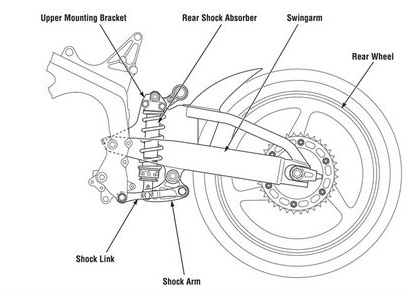Motorcycle suspension
The suspension system is an essential part of any automobile. Not only it protects the rider from road shocks and vibrations but also maintains the stability and improves the handling of the vehicle. It also helps in maintaining the wheel contact with the surface and hence prevents wheel wear. The suspension system basically absorbs the road shocks and damp them using hydraulic fluid. It converts the vibrational energy of road shocks into the heat energy of hydraulic fluid, which get dissipated to the environment. In this post, we will try to understand the suspension system of motorcycles.
Components of a motorcycle suspension
Motorcycle suspensions have three main components i.e.
1.Front forks
2.Rear Coil-overs
3.Swing arms
Now let's see one by one, all these components in detail.
Front Forks
 |
| Front fork with upper slider and lower fork tube |
Most of the motorcycles are fitted with a set of telescopic suspensions at front. The orientation of front forks may vary model to model. Conventionally the thinner section or fork tube is kept at the top while the thicker section or the slider is kept at the bottom. In some sports bikes or some high-performance motorcycles, thicker sections may be fitted at the top, since thicker diameter will help it in sustaining greater forces at the time of handling and road shocks. Also putting the heavier section near to the handle helps in improving manoeuvrability.
The telescopic suspension in bikes have an internal spring to absorb road shocks and damping fluid to damp the vibrations. It contains a piston and a piston rod. The piston has valves and it can move along the piston rod The spring rests over the piston rod. The piston divides this whole assembly into two chambers. When a vehicle receives a shock the lower slider slides over the fork tube. This compresses the spring, and also the piston moves down so the pressure in lower chamber increases. Due to high pressure, the fluid now moves from the lower chamber to the upper one through the damper valves on the piston and compresses the air present over the fluid surface. At the time of rebound, the lower slider moves down and hence the pressure in lower chamber decrease. This causes the fluid in the upper chamber to move to the lower chamber. The movement of the hydraulic fluid through the damper valves causes the damping of shocks. The vibrational energy of fluid gets converted into the heat energy of fluid and finally get dissipated to the environment.
Rear Coil Overs
The rear coil overs are a combination of hydraulic damper and the stiff coil spring. They help in absorbing and damping the shock. The stiff spring helps them to sustain the greater load. Their short length helps in keeping the centre of gravity lower and hence increasing the stability. The damper utilises piston and cylinder arrangement to damp the shocks. The piston contains many orifices or valves through which the hydraulic fluid passes at the time of compression and rebound movements. This movement of hydraulic fluid causes the damping of vibrations. The vibrational energy of spring gets converted into the heat energy of damping fluid and gets lost to the environment.
Swing Arm

Swing arms are arm-like structure pivoted to the frame to support the rear wheel. They connect the wheel to the chassis and provide a suitable mechanism for rear suspensions to work. At the time of jerk, they swing with the wheel about their pivot point. They provide rigidity and stability to the rear wheel and the rear suspension. Shorter swing arm decreases the wheelbase length and hence improves stability and manoeuvrability. Longer swing arms increase the drifting capability of motorcycle and decreases the steering stability. Now some sports bikes are getting fitted with a single swing arm. Single swing arm leads to weight reduction and it also increases the ease of removal of the rear wheels which is a much-needed quality in sports and race bikes.











Wow :)
ReplyDeleteThis is an incredible collection of ideas!
Waiting for more helpful pieces.
You would amazing to read a similar one here-
themotorbiker
Choosing a bike that is suitable for the type of riding you do is a very important decision as if affects how much you will use your bike and enjoy cycling. The first step is finding a supplier that offers a wide range of different styles of bikes, such as mountain bikes, men's bikes, ladies bikes and kid's bikes. golden motors
ReplyDeleteThank you very much for this great post. carros PCs 2021
ReplyDeleteThis is incredible post. I like it.
ReplyDeletebest Hero bikes in India
Which is more basic - getting the right motor or getting the best motorcycle tire - that question might be a hard to reply or an inconceivable choice to make for some.Weblink
ReplyDeletePositive site, where did u come up with the information on this posting?I have read a few of the articles on your website now, and I really like your style. Thanks a million and please keep up the effective work. Curso mecanica de motos
ReplyDeleteI am truly impressed by the details which you have provided regarding professional motorcycle instructor training services. It is an interesting article for me as well as for others. Thanks for sharing such articles here.
ReplyDeleteI always check this type of advisory post and I found your article which is related to my interest. This is a great way to increase knowledge for us. Thanks for sharing an article like this.Campgrounds Coos Bay Oregon
ReplyDeleteYou wrote this post very carefully.Exhaust Pipe Motorcycle The amount of information is stunning and also a gainful article for us. Keep sharing this kind of articles, Thank you.
ReplyDeleteReally appreciate this wonderful post that you have provided for us.Great site and a great topic as well i really get amazed to read this. Its really good. dg-grand
ReplyDelete